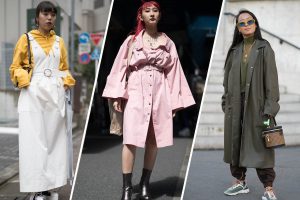When you think about Japanese fashion, you might picture a rich tapestry of tradition meeting modern flair, especially in the art of accessorizing. Imagine kanzashi hairpins and obi belts, timeless pieces, finding their way into contemporary streetwear or chic handbags crafted from kimono fabrics. This isn’t just about looking back fondly at cultural heritage; it’s about pushing creative boundaries and making bold statements. How does this blend influence global trends, and what iconic styles emerge from this fusion? Let’s explore how tradition and innovation intertwine to shape a unique fashion narrative.
flair, especially in the art of accessorizing. Imagine kanzashi hairpins and obi belts, timeless pieces, finding their way into contemporary streetwear or chic handbags crafted from kimono fabrics. This isn’t just about looking back fondly at cultural heritage; it’s about pushing creative boundaries and making bold statements. How does this blend influence global trends, and what iconic styles emerge from this fusion? Let’s explore how tradition and innovation intertwine to shape a unique fashion narrative.
Traditional Accessories
When diving into the world of traditional Japanese fashion, it’s impossible to overlook the significance of accessories like the kanzashi hairpins, obi belts, and tabi socks. Kanzashi hairpins add elegance, often reflecting seasons or events. Obi belts serve as both functional and decorative pieces, cinching the kimono. Tabi socks, with their split-toe design, are essential for wearing traditional footwear like zori and geta.
Modern Influences
While traditional accessories hold a revered place in Japanese fashion, modern influences have dramatically reshaped how these elements are incorporated into everyday wear. Streetwear culture, global fashion trends, and technological advancements have led to innovative reinterpretations. You’ll see kimono fabrics turned into chic handbags or tech-savvy smartwatches paired with traditional garments, creating a dynamic interplay between heritage and contemporary aesthetics.
Fusion Styles
How does the blending of old and new create such enchanting fashion statements? You’ll find that Japanese fashion often marries traditional garments like kimonos with contemporary accessories, creating unique, eye-catching looks. This fusion style honors cultural heritage while embracing modern design, showcasing intricate craftsmanship and innovative aesthetics. It’s a demonstration to how fashion evolves by respecting its roots and pushing creative boundaries.
Iconic Trends
In the domain of Japanese fashion, iconic trends have consistently pushed the envelope, blending the avant-garde with everyday wear. You see this in Harajuku’s vibrant street style, where bold colors and eclectic accessories dominate. Minimalism also thrives, reflecting Japan’s Zen aesthetics through clean lines and subtle adornments. These trends highlight a culture that masterfully marries innovation with deep-rooted traditions.
 transformation happening behind the scenes. When businesses step beyond simply writing checks, they’re revolutionizing how nonprofits operate and succeed. From providing technological infrastructure to offering specialized expertise, corporate sponsorships are reshaping the philanthropic landscape in ways that traditional donations never could. As these partnerships evolve, they’re creating ripple effects that extend far beyond the initial investment—and understanding this shift is crucial for anyone involved in the nonprofit sector or corporate giving.
transformation happening behind the scenes. When businesses step beyond simply writing checks, they’re revolutionizing how nonprofits operate and succeed. From providing technological infrastructure to offering specialized expertise, corporate sponsorships are reshaping the philanthropic landscape in ways that traditional donations never could. As these partnerships evolve, they’re creating ripple effects that extend far beyond the initial investment—and understanding this shift is crucial for anyone involved in the nonprofit sector or corporate giving.